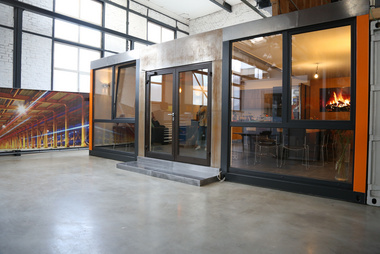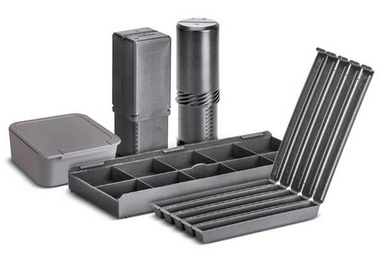Drilling, drilling machines, profile drilling machines
A CNC-controlled drill line with automatic measuring system is operating efficiently in plants processing such profiles as angle steel, beams, U-profiles, rectangular pipes, flat steel, etc. You can drill profiles of different lengths. At the beginnig the CNC-Control will receive data from the CAD system and a post processor will translate the CAD data into the CNC Control. After this operation the machine has all necessary information about the positions of the beam and the drill units. All operations are now running automatically.
As the production range differs from one steel construction company to another, there are different machine sizes available for beams from 300 mm up to 2.000 mm. The standard beam drill lines are suitable for beam profiles up to 1.000 mm size.


Beam drill line moveable on undercarriage
In this case of an economic drill line system it is not the workpiece (= profile) that is moved to the desired drill position but the tool (= drill line) itself.
As the profiles are on a steel frame mounted the CNC controlled drill unit moves along the profile by the longitudinal axis. So it is possible to do the drill process precisely in the desired position. However, the drill process takes place in only one axis – either flange or web. The work piece (profile) has to be turned manually. This system is a starter system for programmed profile machining, but only suitable for a lower output. Manufacturers such as Ficep, Voortman and Peddinghaus deliver this system.
Drill line, drilling machine with CNC control
In the past regular HSS dry core drills have been used which have been replaced since 1988 by the almost exclusively use of inner coolant drills. Since ca. 2004 the use of carbide drills or drilling with KSEM cutting body became possible. In this field one of the leading manufacturers is Kennametal.
See the following examples for beam drill lines






Material flow and length measuring system on drill lines
You can choose between 3 different measuring systems – roller feed with measuring disc, gripper feed, measuring carriage with driving rod and the positioning of the drill unit. In combination with a handling system, the measuring system provides for a material positioning and simultaneously for a length measuring. The particular measuring system differs according to the machine manufacturer. The measuring systems allow for an accurate positioning of the material. The positioning has to be in accordance with the necessary tolerances in the structural steelwork. It is advised to exercise a check-up at regular intervals. This is to provide for a reliable repeat accuracy of the measuring systems.
Roller feed measuring on beam drill lines and plate processing machines
The roller feed with disc measuring system consists of a combination of rugged, driven feed rolls and separately hardened measuring discs. The driven feed rolls are clamping the profile. And through the rotation of the feed rolls the profile is moved in its longitudinal axis. Separate measuring discs identify the actual position of the profile by digital rotary encoders. The identified data are passed down to the CNC-control for monitoring purposes. Drill lines with integrated roller feed and disc measuring feature one particular advantage, namely that they save valuable floor space. Manufacturers such as VOORTMAN and KALTENBACH are using this kind of measuring system.
Gripper feed measuring on beam drill lines and plate processing machines
The gripper feed consists of a measuring arm that is moved sideways on a roller conveyor by means of a gear rod. At the end of this arm there are gripping pliers that clamp the workpiece and move it through the drill line on its specified position. If you are working on a saw/drill line, the gripper feed system features the advantage that there is barely residual length. A certain disadvantage follows from its increased space requirements. Machine manufacturers such as FICEP and VOORTMAN apply this system.
Measuring carriage with driven rod on beam drill lines
The measuring carriage or the so called stop positioning system consists of a measuring arm that is moved sideways on a roller conveyor by means of a gear rod. At the end of this measuring arm there is a plate which is provided with a sensor. The material is moved by the driven roller conveyors to the plate. Via sensor the control gets to know that the beam arrived the plate. The measuring carriage moves the workpiece through the drill line on its specified position. The measuring carriage features the advantage that there is barely residual length. A certain disadvantage follows from its increased space requirements. Machine manufacturers such as KALTENBACH, WAGNER apply this system.





Tool changer
Many modern machines are equipped with a tool changing systems. This provides for flexible operation of the machine. The tool changer is operated by the CNC-control. Different diameters or types of tools can be changed automatically during the machine is drilling. These systems feature one particular advantage, namely that they can be operated extremely flexible.


Marking unit
The marking unit as an additional option can mill any identification number or character. This enables a better identification of the profiles. The marking process is programmed on the CNC-control. On modern drill lines the profiles are marked by means of needles or end mills. It is important to make sure that the marking can be chosen deep enough, so that you can read the numbers or characters even after the galvanizing process.



Drill unit for HSS oil feed drills (inner coolant drills)
For the use of HSS oil feed drills, drilling spindle speeds of up to 1000 rpm and drive powers up to 7.5 KW are sufficient.
A coolant supply with at least 6 bar of compressed air power is necessary for good cooling lubrication at the drill cutting edge.
Drill unit for Kennametal KSEM carbide drills and solid carbide drills
For the use of KSEM carbide drills or solid carbide drills very stable machines with good workpiece clamping are necessary. In addition, high drilling spindle speeds and high drive power are required. Speeds of over 2000 rpm are not unusual.
The drilling rates of carbide drills, such as the KSEM cutting bodies from Kennametal, are much faster than conventional HSS inner coolant drills due to the high feed rate.
Latest news

New, modern cafeteria inaugurated at Nenok: an oasis for employees and visitorsThe new cafeteria (Kaffeetine) at Nenok was inaugurated today with a joint cooking event. The high-quality interior not…

Vielen Dank für Ihre Treue und Ihr Vertrauen und auf ein erfolgreiches Jahr 2024.Das Nenok-Team möchte sich herzlich für die partnerschaftliche Zusammenarbeit im vergangenen Jahr bedanken und freut…

Liebe Geschäftspartnerinnen und liebe Geschäftspartner aus dem Stahlbau und Stahlhandel,im festlichen Glanz der Weihnachtszeit möchten wir uns herzlich bei Ihnen für Ihre Treue und Zusammenarbeit…

Hartner is setting a milestone in the area of sustainability by gradually introducing packaging made from recycled plastic with immediate effect. This innovative measure makes Hartner the first German…
 Deutsch
Deutsch  English
English  Polska
Polska  Nederlands
Nederlands  Français
Français  Español
Español 

